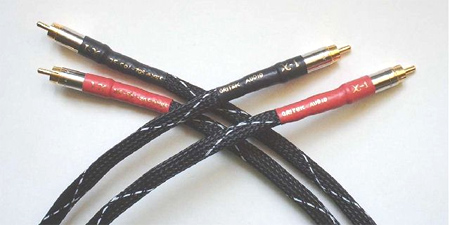You are reading the older HTML site
Positive Feedback
ISSUE
20
july/august
oritek
X-1 interconnects
as reviewed by Francisco Duran

|
FRANCISCO DURAN'S SYSTEM LOUDSPEAKERS ELECTRONICS SOURCE CABLES ACCESSORIES
|
When I first heard about the Oritek X-1 interconnects, I felt more than a bit of skepticism. Here was another set of inexpensive wonder cables poised to wreak havoc upon the competition. Unfortunately for the X-1s, they arrived when other contenders, the Harmonic Technology Cyberlights, were here for a listen. The Cyberlights' nonexistent capacitance and resistance almost perfectly matched my Reference Line passive preamp. The X-1s had their work cut out for them!
The X-1s are not physically impressive, as we high-enders are used to big, stiff,
cables terminated with audio jewelry. The X-1s, with their flexibility and simplicity of construction, look almost hand made compared to the monster hoses that populate high-performance audio. Don't misunderstand—the X-1s are very well built. The connectors fit snugly, and they took this old audio reviewer's abuse with no problem. I didn't use them for jump ropes, but they stood up to many installations.
I was told that the X-1s needed no break-in! Say what? But the X-1s again proved this skeptic wrong, because in the two months they were here, the sound didn't change. First I listened to the X-1s for awhile, then I compared them to my Analysis Plus Solo Crystals, then to the Cyberlights. Playing the usual assortment of CDs and DVDs showed that the X-1s were fast, clean, and largely grain free. They were also very balanced. No part of the frequency spectrum was emphasized. The transition from bass to treble sounded smooth. I tested this with Respighi's Church Windows (with Jesus Lopez-Cobos and the Cincinnati Symphony), and the X-1s sailed right through. The bass was full, with no foot-dragging. The treble was clean and extended. When I switched to jazz and rock, the midrange sounded tonally correct, especially with acoustic guitars. When I tried some gut-wrenching hard-rock electric guitars, the X-1s had no problem. I could easily distinguish the sound and texture of each musician, and the character of each band.
The X-1s were doing so well that the itch to swap cables was irresistible, so in went the Analysis Plus Solo Crystals. I immediately noticed that the APs were more full-bodied. Those grungy guitars suddenly gained some weight, and the Cincinnati Orchestra filled out a bit. The APs also had more authoritative bass—not by much, but it was easily heard. I slipped the Obrigado Brazil disc by Yo Yo Ma in the player, and went back and forth between the two cables. In addition to the differences I have already described, I heard a slight but noticeable difference in the soundstage. The APs' stage was slightly wider and more spacious, though the X-1s countered with a very extended and clean treble. The trailing edge of the notes coming from Yo Yo Ma's cello were more easily heard. Transients sounded sharper, brighter, and more incisive. They were not bright, just very clean. The X-1s also revealed the Analysis Plus cables to be a tad pinched in the midrange. They had a slight emphasis from the upper midrange to the very top end, and a very slight glare. This was surprising. Here was a relatively inexpensive upstart interconnect showing up my babies in the very area of their greatest strength.
With this, I got down and dirty, and let the X-1s have a go with the Harmonic Technology Cyberlights. Again to the surprise of the listening gallery, the X-1s came away smelling like roses. To my surprise, the X-1s were darn near as clean and detailed as the Cyberlights. They sounded slightly thinner, which I could hear as a lack of body with guitars and violins, and a lack of flesh around vocals. Sibilance was a tad more silvery. Within the wide soundstage, images were very stable and very detailed, though slightly flatter. The Cyberlights also bettered the X-1s in stage depth. The differences between the two cables were slight, but the difference in price is anything but.
The Oritek X-1 interconnects proved their worth and then some. They worked very well with all of the tube and solid state amplifiers that grace my system. They held their own with much more expensive cables. The only other affordable competition for them costs quite a bit more. As with anything in the high end, system synergy is of the utmost importance, and this seems to be especially true with cable, but the X-1s were consistently clean, detailed, extended, coherent, and free of strain. Although not the fullest sounding cables, they did not achieve their resolution at the expense of excessive brightness. They are great cables for a great price. Francisco Duran
Read Larry Cox's take on the Oriteks here.
X-1 interconnects
Retail: $249 a meter
Oritek
web address:
http://members.ispwest.com/orim/audio/x-1.html
